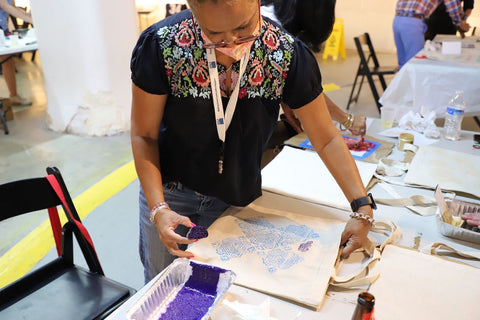What is Hand Block Printing?
Hand block printing
We recently taught a class in New Orleans on block printing! How fun is that?! If you missed it or aren’t local, we’re doing a recap of what block printing is since it’s such an important process in Passion Lilie’s garment making process. Read on!

What is block printing?
The centuries-old art form starts with a simple piece of wood. In India, the native teak tree is preferred for woodblock printing. The wood is hand-carved into any shape the designer wishes to use. Many times, you’ll see designs inspired by nature in the clothing made in India, or else symbols relating to Indian beliefs and customs.
As you may know, most of Passion Lilie’s garments are made in India where our artisans incorporate this technique. These ancient methods are vibrant, unique, and treasured around the world.

Here’s what block printing involves for clothes made in India (we made totes at our class in NOLA)
First the designer creates a design or pattern for the fabric on the computer or paper. A master craftsman then traces the design onto the block and chips away the block to create the design. Creating the block can take 7 to 10 days, depending on the complexity of the design!
The fabric is pre-washed, most often in a local river or waterway (in order to reduce water consumption!). Four to five basic colors are used that are mixed together to form a multitude of colors. Also, the colors are sometimes made with vegetables or plants in order to create a natural dye. How fun and eco-friendly is that?! The fabric is dyed its base color and prepared for printing.
To prevent smudges or uneven printing, the fabric is laid flat on a table and secured with pins. The block is dipped in dye. Then, the block is stamped forcefully onto the fabric, either by hand or with the help of a small hammer. The printing process repeats if any other colors are included in the design. Each color must be applied individually with a separate block. After the dye dries, the fabric is rinsed in water and dried in the sun. Pretty cool, huh?

Good printing requires skill + practice
It's true! Because it's a true art form, good printing requires skill and practice in order to create uniformity and clear block printing patterns. The duration and cost for printing depends on the number of colors used i.e. single color printing takes less time and has a lower cost whereas two or more color printing requires more time, hard work and ink.
Don't forget!
Although our designs are created in New Orleans, all of our clothing is made in India. Even more importantly, we offer our Indian artisans fair wages and dignified, long-term employment, so every purchase supports our talented artists and their craft.
Tell me more about the history
Block printing was popularized in China and many other East Asian countries, but it was in India where it really hit upon its highest visual expression. Block printing actually began in the state of Andhra Pradesh in a fishing village called Machilipatnam in the 16th century and later travelled to Northern India to the state of Rajasthan. Before the 16th century, fabrics were hand painted with natural dyes and the process was called Kalamkari. The advent of etching a design into a block and stamping the fabric with that block decreased the cost of printed fabrics and made these types of fabrics popular for fashion and home decor. Sadly, the block printing art form died off in the 17th century. But thanks to a few good people, the art form was revitalized in the 1960s.

Try it at home!
We loved hosting our class locally in New Orleans. If you want to try your hand at block printing, get some fabric paint such as Jacquard Versatex Screen Printing Ink. We often host classes in person and virtually, so if you want to be the first to know when we host our next class, sign up for our newsletter!


Leave a comment